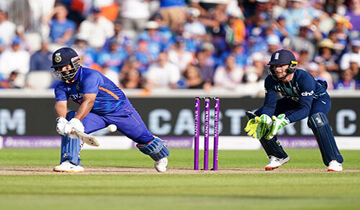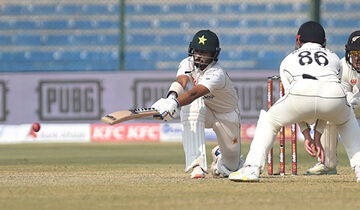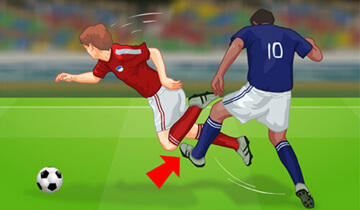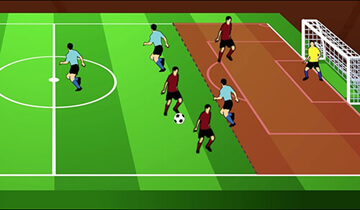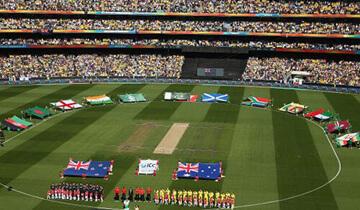Cricket is a bat-and-ball sport that is played between two teams, each consisting of eleven players. It is one of the most popular sports in the world with over 2.5 billion fans. Cricket involves elements of batting, bowling, and fielding. The objective of the game is to score more runs than the opposition. Let’s look at the basics of how to play cricket.
The Basic Equipment for Playing Cricket
The Cricket Bat
Cricket bats are traditionally made of wood, flat on one side and bulged on the other. They are used by the batsman to hit the ball and score runs. Bats come in various sizes, weights, and shapes to suit each player’s preferences.
The Cricket Ball
The cricket ball is similar to a baseball, made of leather with prominent raised seams. Cricket balls are traditionally dyed red with white stitching. The ball is bowled by the bowler towards the batsman who tries to hit it. Fast bowlers can deliver the ball at speeds over 90mph.
The Pitch
Cricket matches are played on an oval-shaped grass field called the pitch. At each end of the pitch are three wooden posts called stumps hammered into the ground.
The Wickets
Balanced loosely on top of the stumps are two small sticks called bails. Together, the stumps and bails make up the wicket.
The Boundary
The perimeter of the cricket field is marked by a boundary rope, fence or marked lines. When the ball is hit over or past the boundary, the batting team is awarded four or six runs depending on where it lands.
Additional Gear
In addition to this basic equipment, cricket players also use protective gear like helmets, pads and gloves. However, at its core only a bat, ball, wickets and a field are needed to play an exciting game of cricket.
The Players and Positions in Cricket
The Teams
Cricket is played by two teams of 11 players each. Despite having 11 players per team only 2 players from the batting team are on the actual pitch at any time. The rest of the players fill various roles and positions.
The Key Positions
The key positions in a cricket team are batsmen, bowlers, wicket-keeper and fielders. Batsmen are the offensive players tasked with scoring runs for the team. The batting team has 2 batsmen on the pitch at once, with the rest waiting in the pavilion to bat in pairs.
The Bowlers
Bowlers are the defensive players who bowl the ball towards the batsman. A cricket team has multiple bowlers who take turns bowling from one end of the pitch. Fast bowlers rely on speed while spin bowlers use spin and deception to get batsmen out.
The Wicket-Keeper
The wicket-keeper is a specialized fielding position stationed directly behind the batsman’s wicket. Their job is to catch balls that the batsman misses or edges. The wicket-keeper wears gloves and pads to protect from the ball.
The Fielders
The rest of the players spread out across the field are called fielders. Fielders either catch balls to get batsmen out or throw the ball back to prevent runs being scored. The fielding positions have specific names like slip, gully, cover, mid-on, third man etc. based on where they stand.
Positions and Strategy
With 11 players on each side, everyone gets a chance to bat, bowl and field. The variety of roles and tactical options make positioning and strategy crucial in cricket.
The Objective and Scoring Runs in Cricket
The Primary Objective
The primary objective in cricket is to score more runs than the opposing team. Runs are the fundamental unit of scoring for the batting team.
Scoring Runs by Running Between Wickets
The most common way to score runs is when the batsmen run between the wickets after one of them hits the ball. The pitch in cricket has wooden wickets placed 22 yards apart at each end. The two batsmen on the field stand in front of these wickets on either end of the rectangular pitch.
When the batsman hits the ball, the two batsmen have to swap ends of the pitch to score 1 run. Both players must ground their bats behind the popping crease line before turning back for the next run. If they successfully run two times between the wickets, 2 runs are scored. This can continue with the batsmen running multiple times back and forth as long as the ball is in play.
Scoring Boundary Runs
Runs can also be scored if the ball is hit past the boundary rope or perimeter of the cricket ground. When this happens 4 runs are automatically awarded to the batting team. If the ball is hit over the boundary line without bouncing, 6 runs are scored.
Additional Runs
Additional runs can be given for no-balls, wides, byes and overthrows. But primarily, runs are accumulated through the two batsmen coordinating and exchanging ends of the pitch after one of them hits the ball into play.
Objective is to Score More Runs
The team with the higher number of runs at the end of both innings wins the match. So the aim in cricket is to strategically score more runs than the opposition by effectively running between wickets and hitting boundaries.
The Fundamentals of Cricket Gameplay
Innings
- Innings - Before the match, the number of innings per team is agreed upon, usually 2 innings each.
Batting and Bowling
-
Batting - Two batsmen from the batting team are on the pitch at any time, with one at each wicket end.
-
Bowling - A player from the fielding team called the bowler bowls the ball repeatedly from one end to the batsman at the other end.
Scoring Runs
- Runs - The batsman tries to hit the ball and run back and forth between the wickets with their batting partner to score runs.
Fielding
- Fielding - Players from the fielding team spread out to catch the ball or prevent runs. Getting a batsman out transfers that role to the fielding team.
Overs
- Overs - After a set number of bowls (usually 6), the bowler switches ends and starts bowling to the other batsman. The batsmen may also change strike.
Innings End
- Innings End - The batting team’s innings is over when 10 batsmen get out or the allocated time/overs are completed.
Switching Sides
- Switch - After one innings is over, the two teams switch roles between batting and fielding.
Winning the Game
- Result - The team with the higher total runs scored across all their innings is declared the winner.
The Essence of Cricket
This sequence of alternating objectives, with one team trying to score runs and the other attempting to limit them, is the essence of cricket’s gameplay and what makes it exciting.
How Runs Are Scored in Cricket
There are several ways a batting team can score runs in cricket. Here are the main methods of scoring runs:
- Running Between Wickets - The most common way to score is for the two batsmen to run back and forth between the wickets after one of them hits the ball. Each time both batsmen successfully complete a run, 1 run is scored.
- Boundaries - If the batsman hits the ball past the boundary rope or perimeter of the field, 4 runs are automatically awarded. If the ball crosses the boundary without bouncing, 6 runs are scored.
- Wides - If the bowler bowls a wide ball outside the batsman’s reach, extra runs are awarded as penalty to the batting team.
- No Balls - When a bowler oversteps the crease or bowls illegally, the batting team gets runs added for a ’no ball'.
- Byes - If the ball evades the wicket-keeper and fielders after the batsman misses it, any runs scored are called ‘byes’.
- Leg Byes - Runs scored after the ball hits the batsman’s body and goes away from the fielders are called ’leg byes'.
Through strategic hitting, quick running, and capitalizing on extras, a batting team aims to optimize their run scoring. The cumulative runs of the two batsmen on the pitch are what make up the team’s total score in an innings. Maximizing runs is crucial to winning cricket matches.
So by combining boundaries, running between wickets, and extras, a batting team has multiple ways to steadily build their run count and outscore their opponents.
How Batsmen Get Out in Cricket
Bowled
- Bowled - The most common dismissal. This happens when the bowler hits the batsman’s wicket directly with the ball and dislodges the bails.
Caught
- Caught - When the batsman hits the ball in the air and it is caught by a fielder before it touches the ground, they are out ‘caught’.
LBW
- LBW - ‘Leg before wicket’ rules a batsman out if the ball hits their leg pads first before hitting the wicket they are guarding.
Hit Wicket
- Hit Wicket - If in the act of playing a shot or taking off for a run, the batsman knocks their own wicket over, this results in them being out ‘hit wicket’.
Run Out
- Run Out - A batsman is ‘run out’ if the fielding team breaks the wicket with the ball while the batsman is still running between the wickets.
Stumped
- Stumped - On a delivery that the batsman misses, if the wicket-keeper catches the ball and breaks the wicket before the batsman gets back, they are out ‘stumped’.
Handling Ball
- Handling Ball - If a batsman wilfully handles the ball with a hand that is not touching their bat, this illegal act gets them out ‘handled ball’.
Importance of Dismissals
Getting each batsman out is the primary task of the fielding team. Once 10 batsmen are dismissed, the batting team’s innings is over. So bowlers and fielders employ various tactics to achieve these dismissals and restrict their opponents’ scoring.
Conclusions
In conclusion, cricket is a bat-and-ball sport contested between two teams. The game takes place on a large field with wickets at either end of a central pitch. The aim is to score more runs than the opponent. Runs are scored by batsmen hitting the ball and running between wickets. Teams take turns batting and fielding. The fielding team tries to get batsmen out through methods like bowling, catching, stumping etc. After all innings are completed, the team with the highest run total wins the match. In essence, cricket is a contest between bat and ball with the exciting back-and-forth of one team trying to score runs while the other attempts to limit them.


































